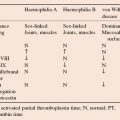B12 deficiency
Clinical features
- Gradual onset of features of anaemia.
- Mild jaundice, caused by ineffective erythropoiesis (Fig. 12.1).
- Glossitis and angular cheilosis and, if severe, sterility (either sex) and reversible melanin skin pigmentation.
- B12 deficiency causes a symmetrical neuropathy affecting the pyramidal tracts and posterior columns of the spinal cord (subacute combined degeneration of the cord) and the peripheral nerves. Patients present with tingling in the feet (more than the hands), difficulty in gait, visual or psychiatric disorders.
- B12 or folate deficiency in pregnancy is associated with increased incidence of fetal neural tube defects, e.g. spina bifida.
- Patients may be asymptomatic and detected by a routine blood test.
Laboratory findings
- Macrocytic anaemia with oval macrocytes and hypersegmented neutrophils (more than five nuclear lobes) (Fig. 12.2).
- Moderate reduction in leucocyte and platelet counts (severe cases).
- Biochemical tests in anaemic patients show raised serum bilirubin (indirect), lactate dehydrogenase.
- In B12 deficiency, the serum B12 is low, serum folate is normal or raised and red cell folate is normal or low.
- Bone marrow is hypercellular, increased proportion of early cells, megaloblastic erythropoiesis and giant metamyelocytes (Fig. 12.3).
- Raised serum methylmalonic acid (B12 deficiency), raised serum homocysteine (either B12 or folate deficiency).
Tests for causes of B12 deficiency
These include history (diet, previous gastrointestinal surgery), tests for intrinsic factor (IF), antibody (positive in 50% of cases of PA) and parietal cell antibodies (positive in 90% of cases of PA), serum gastrin level (raised in PA) and upper gastrointestinal endoscopy.
Treatment
Treatment of B12
Stay updated, free articles. Join our Telegram channel

Full access? Get Clinical Tree




